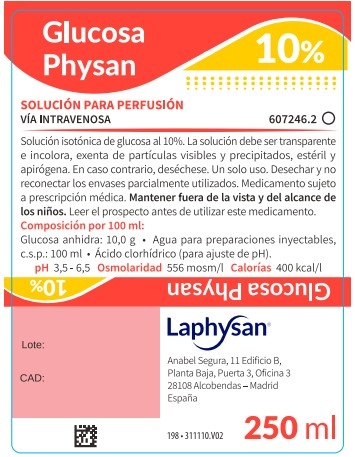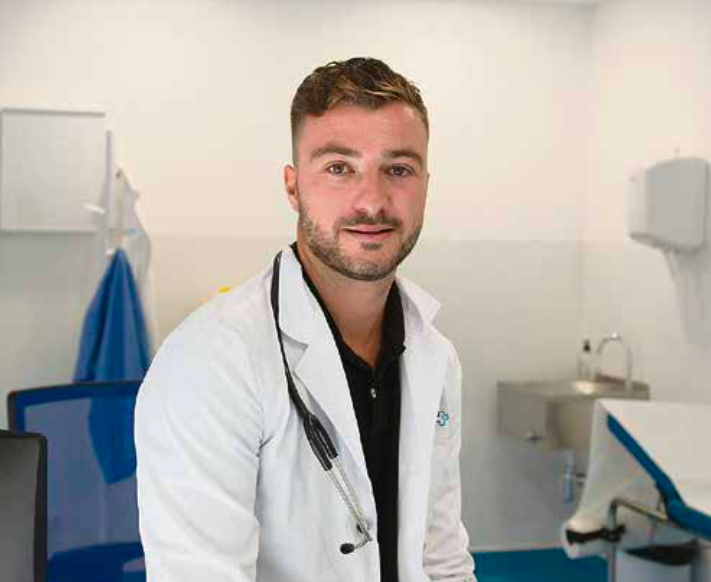

ГЛЮКОЗА ФІЗАН 10% РОЗЧИН ДЛЯ ІНФУЗІЙ

Запитайте лікаря про рецепт на ГЛЮКОЗА ФІЗАН 10% РОЗЧИН ДЛЯ ІНФУЗІЙ

Інструкція із застосування ГЛЮКОЗА ФІЗАН 10% РОЗЧИН ДЛЯ ІНФУЗІЙ
Вступ
Опис: інформація для користувача
Глюкоза Фізан 10%, розчин для інфузії
Глюкоза безводна
Прочитайте уважно весь опис перед тим, як почнете використовувати цей лікарський засіб, оскільки він містить важливу інформацію для вас.
- Збережіть цей опис, оскільки вам може знадобитися знову його прочитати.
- Якщо у вас виникли питання, проконсультуйтеся з вашим лікарем, фармацевтом або медсестрою.
- Якщо ви відчуваєте побічні ефекти, проконсультуйтеся з вашим лікарем, фармацевтом або медсестрою, навіть якщо це побічні ефекти, які не наведені в цьому описі. Див. розділ 4.
Зміст опису
- Що таке Глюкоза Фізан 10% і для чого вона використовується.
- Що потрібно знати перед тим, як почати використовувати Глюкозу Фізан 10%
- Як використовувати Глюкозу Фізан 10%
- Можливі побічні ефекти
- Зберігання Глюкози Фізан 10%
- Зміст упаковки та додаткова інформація
1. Що таке Глюкоза Фізан 10% і для чого вона використовується
Глюкоза Фізан 10% належить до групи розчинів для парентерального харчування, призначених для забезпечення водою та енергією.
Вона показана для лікування гіпертонічної дегідратації (воміту, діареї, сильної потовиділення, гастроінтестинальних фістул), як джерело енергії при парентеральному харчуванні, при порушеннях метаболізму вуглеводів (гіпоглікемії, інсуліновому комі, печінковому комі, ацетонемічному комі) та як транспортний засіб для введення сумісних лікарських засобів.
2. Що потрібно знати перед тим, як почати використовувати Глюкозу Фізан 10%
Не використовуйте Глюкозу Фізан 10%:
Якщо ви алергічні на глюкозу безводну або на будь-який інший компонент цього лікарського засобу (наведені в розділі 6).
- Якщо у вас виявлена гіпотонічна дегідратація, втрату солей або зниження об'єму сечі.
- У перші 24 години після черепно-мозкової травми.
- У стані гіперглікемії.
- У стані гіпергідратації, загального набряку.
- Якщо у вас є гіперлактацидемія.
- Якщо ви страждаєте важкими порушеннями толерантності до глюкози, включаючи гіпертонічний кома.
Попередження та обережність
Проконсультуйтеся з вашим лікарем, фармацевтом або медсестрою перед тим, як почати використовувати Глюкозу Фізан 10%.
- Концентрація глюкози в крові повинна бути під суворим контролем у випадках внутрішньочерепної гіпертензії.
- У разі гострих ішемічних атак (зниження або відсутність кровотоку в артеріях), оскільки гіперглікемія пов'язана з підвищенням ішемічного ушкодження мозку та труднощами у відновленні.
- У разі шоку та порушення балансу кислотно-лужної рівноваги пацієнти повинні бути оброблені введенням електролітів перед введенням глюкозних розчинів. У пацієнтів з дефіцитом натрію введення розчинів без натрію може призвести до периферичного колапсу та олігурії (малої кількості сечі).
- Рекомендується регулярно проводити контроль рівня глюкози, електролітів, водного балансу та кислотно-лужної рівноваги, оскільки часте та масивне введення парентеральних глюкозних розчинів може призвести до надмірного накопичення рідини (гіпергідратації) та важких іонних дефіцитів. У цьому випадку буде необхідним введення електролітних добавок.
- Для уникнення гіпокаліємії, яка виникає під час тривалого парентерального харчування глюкозою, можна додавати калій до глюкозного розчину як заходи безпеки.
- Якщо у вас є недохранення, ви можете мати дефіцит вітаміну В1. Ця вітамін необхідна для метаболізму глюкози, тому якщо це необхідно, цей дефіцит повинен бути виправлений спочатку.
- Якщо ви страждаєте цукровим діабетом. У цьому випадку глюкозні розчини можуть бути використані завжди, якщо вам було призначено відповідне лікування (інсулін). Рівень глюкози в крові повинен бути під суворим контролем у пацієнтів з цукровим діабетом та коригуватися потреби в інсуліні.
- Не вводіть кров одночасно, використовуючи те саме обладнання для інфузії, через ризик псевдоаглютинації та/або гемолізу.
- Якщо вводиться постійно в одному місці інфузії, може виникнути тромбофлебіт (запалення вен).
- Потрібно звернути особливу увагу, якщо використовується у пацієнтів похилого віку, оскільки вони можуть мати порушення функції печінки та/або нирок.
- Не вводіть внутрішньом'язово.
Глюкозні розчини для інфузії загалом ізотонічні. Однак у організмі глюкозні розчини можуть стати надзвичайно гіпотонічними фізіологічно через швидкий метаболізм глюкози
Залежно від тонічності розчину, об'єму та швидкості інфузії та початкового клінічного стану пацієнта та його здатності метаболізувати глюкозу, внутрішньовенне введення глюкози може призвести до порушення електролітного балансу, найважливішим з яких є гіпонатріємія.
Гіпонатріємія:
Пацієнти з некосмоторною виділенням вазопресину (напр., при наявності критичних станів, болю, післяопераційного стресу, інфекцій, опіків та захворювань центральної нервової системи), пацієнти з захворюваннями серця, печінки та нирок та пацієнти, які піддаються впливу агоністів вазопресину, мають підвищений ризик розвитку гострої гіпонатріємії після інфузії гіпотонічних розчинів.
Гостра гіпонатріємія може призвести до розвитку гострої гіпонатріємічної енцефалопатії (едему мозку) з характерними симптомами, такими як головний біль, нудота, судоми, летаргія та блювота. Пацієнти з едемою мозку мають підвищений ризик розвитку важкого, незворотного та потенційно смертельного ушкодження мозку.
Діти, жінки репродуктивного віку та пацієнти з зниженою еластичністю мозку (напр., при менінгіті, внутрішньочерепному крововиливі та ушкодженні мозку) мають підвищений ризик розвитку важкого та потенційно смертельного едему мозку, викликаного гострою гіпонатріємією.
Використання Глюкози Фізан 10% з іншими лікарськими засобами
Повідомте вашому лікареві або фармацевту, якщо ви використовуєте, нещодавно використовували або можете використовувати будь-який інший
лікарський засіб.
Важливо повідомити вашому лікареві, якщо ви використовуєте будь-який з наступних лікарських засобів:
- Інсулін або пероральні антидіабетичні засоби (бігuanіди, сульфонілуреї): Внутрішньовенне введення глюкози у пацієнтів, які приймають інсулін або пероральні антидіабетичні засоби, може знижувати їхню ефективність (протилежна дія).
- Кортикостероїди: Внутрішньовенне введення глюкозних розчинів у пацієнтів, які приймають системні кортикостероїди з глюкокортикоїдною активністю (кортизол), може призвести до значного підвищення рівня глюкози в крові через гіперглікемічну дію цих засобів. Що стосується кортикостероїдів з мінералокортикоїдною активністю, вони повинні бути введені з обережністю через їхню здатність утримувати воду та натрій.
- Глюкозиди дигоксину (дигоксин): Якщо внутрішньовенне введення глюкози збігається з лікуванням глюкозидами дигоксину (дигоксином), може виникнути підвищення активності дигоксину, що підвищує ризик розвитку інтоксикації цими лікарськими засобами. Це відбувається через гіпокаліємію, яку може викликати введення глюкози, якщо не додавати калій до розчину.
У будь-якому випадку лікар повинен перевірити сумісність додаваних лікарських засобів.
Лікарські засоби, які посилюють дію вазопресину
Наступні лікарські засоби підвищують дію вазопресину, що призводить до зниження виділення води без електролітів та підвищення ризику госпітальної гіпонатріємії після неправильно збалансованого лікування інфузійними розчинами.
- Лікарські засоби, які стимулюють виділення вазопресину; наприклад: хлорпропамід, клофібрат, карбамазепін, вінкристин, селективні інгібітори зворотного захоплення серотоніну, 3,4-метилендіоксі-N-метамфетамін, іфосфамід, антипсихотичні засоби, наркотичні засоби
- Лікарські засоби, які посилюють дію вазопресину; наприклад: хлорпропамід, НПВС, циклофосфамід
- Аналоги вазопресину; наприклад: десмопресин, окситоцин, вазопресин, терліпресин
Інші лікарські засоби, які, як відомо, підвищують ризик гіпонатріємії, включають діуретики загалом та антиепілептичні засоби, такі як окскарбазепін
Вагітність, лактація та фертильність
Глюкоза Фізан 10% повинна бути введена з особливою обережністю у вагітних жінок під час пологів, особливо якщо вона вводиться в поєднанні з окситоцином, через ризик гіпонатріємії
Якщо ви вагітні або перебуваєте в період лактації, вважаєте, що можете бути вагітною або плануєте вагітність, проконсультуйтеся з вашим лікарем або фармацевтом перед тим, як використовувати будь-який лікарський засіб.
У разі вагітності ваш лікар вирішить про доцільність використання 10% глюкозного розчину, оскільки його слід використовувати з обережністю в цьому випадку. Введення глюкози внутрішньовенно під час вагітності може підвищити рівень глюкози та інсуліну, а також компонентів крові плода.
Немає даних, які свідчать про те, що Глюкоза 10% може викликати побічні ефекти під час лактаційного періоду в новонародженому. Тим не менш, рекомендується використовувати з обережністю під час цього періоду.
Водіння транспортних засобів та використання машин:
Не застосовується.
3. Як використовувати Глюкозу Фізан 10%
Ваш лікар призначить найвідповідальнішу дозу для ваших потреб. Зазвичай рекомендується внутрішньовенне капельне введення згідно з вашим віком, масою тіла, клінічним станом та метаболічним станом.
У дорослих максимальна доза становить 20 мл/кг маси тіла на добу, а максимальна швидкість інфузії становить
2,5 мл/кг маси тіла на годину = 0,25 г/кг маси тіла на годину.
Використання у дітей
У дітей швидкість інфузії залежить від віку та маси дитини та зазвичай не повинна перевищувати 10-18 мг глюкози (0,1-0,18 мл розчину)/кг/хв.
0-10 кг: 50 мл/кг/24 год
10-20 кг: 500 мл + 25 мл/кг/24 год для маси понад 10 кг.
Більше 20 кг: 750 мл + 10 мл/кг/24 год для маси понад 20 кг.
(Див. також розділ 6).
Якщо вам було введено більше Глюкози Фізан 10%, ніж потрібно:
У разі передозування може виникнути гіперглікемія, глюкозурія, гіпергідратція або порушення електролітного балансу. Введення буде зупинено, і буде проведено симптоматичне лікування.
У разі передозування проконсультуйтеся з Токсикологічною службою. Телефон: 91 562 04 20.
4. Можливі побічні ефекти
Як і всі лікарські засоби, цей лікарський засіб може викликати побічні ефекти, хоча не всі люди їх відчувають.
Може виникнути гіперглікемія, глюкозурія (глюкоза в сечі) або порушення балансу рідини чи електролітів, якщо введення проводиться занадто швидко або якщо об'єм рідини надто великий, або у випадках метаболічної недостатності.
З іншого боку, гіперглікемія, яка виникає внаслідок швидкої інфузії або надмірного об'єму, повинна бути під суворим контролем у важких випадках цукрового діабету, оскільки її можна уникнути, знижуючи дозу та швидкість інфузії або вводячи інсулін.
Може виникнути місцева реакція в місці ін'єкції.
Якщо ви відчуваєте будь-які з цих побічних ефектів, повідомте вашому лікареві, який вирішить про доцільність припинення лікування.
Якщо цей лікарський засіб використовується як транспортний засіб для введення інших лікарських засобів, характер додаваних лікарських засобів визначатиме ймовірність інших побічних ефектів.
Якщо ви спостерігаєте ці побічні ефекти або будь-який інший, який не наведений в цьому описі, проконсультуйтеся з вашим лікарем або фармацевтом.
Побічні ефекти
Порушення метаболізму та харчування з гіпонатріємією госпітального типу** невідомої частоти.
Порушення нервової системи з гіпонатріємічною енцефалопатією** невідомої частоти.
** Гіпонатріємія госпітального типу може призвести до незворотного ушкодження мозку та смерті через розвиток гострої гіпонатріємічної енцефалопатії
Звіт про побічні ефекти
Якщо ви відчуваєте будь-який побічний ефект, повідомте вашому лікареві, фармацевту або медсестрі, навіть якщо це можливі побічні ефекти, які не наведені в цьому описі. Ви також можете повідомити про них безпосередньо через Систему фармакологічного нагляду за лікарськими засобами для людини: www.notificaRAM.es. Надсилаючи повідомлення про побічні ефекти, ви можете допомогти надати більше інформації про безпеку цього лікарського засобу.
5. Зберігання Глюкози Фізан 10%
Тримайте цей лікарський засіб поза зоною досяжності дітей.
Не потрібні спеціальні умови зберігання.
Не використовуйте цей лікарський засіб після закінчення терміну придатності, який вказаний на етикетці після CAD. Термін придатності - останній день місяця, який вказаний.
Не використовуйте цей лікарський засіб, якщо ви спостерігаєте видимі ознаки псування.
Лікарські засоби не повинні викидатися у водопровідні труби чи сміття. Спитайте вашого фармацевта, як позбутися упаковки та лікарських засобів, які вам більше не потрібні. Таким чином, ви допоможете захистити навколишнє середовище.
6. Зміст упаковки та додаткова інформація
Склад Глюкози Фізан 10%
- Активний інгредієнт - глюкоза. Кожні 100 мл розчину містять 10 г глюкози безводної (11 г у вигляді глюкози моногідрату).
- Інші компоненти (експіцієнти) - вода для ін'єкційних препаратів, хлоридна кислота (для регулювання pH).
Теоретична осмолярність: 556 мосм/л. Теоретична калорійність: 400 ккал/л.
pH: 3,5-6,5
Вигляд продукту та зміст упаковки
Прозорий розчин, гіпертонічний, апірогенний та стерильний.
Глюкоза Фізан 10% - це розчин для інфузії, який випускається в упаковках по 250 мл та 500 мл.
Для індивідуальних упаковок:
Випускається у флаконах: скло типу II та поліпропілен (PP).
Також у мішках: поліпропілен (PP) та полівінілхлорид (PVC).
У наступних об'ємах:
- Флакон та мішка по 250 мл
- Флакон та мішка по 500 мл
Для клінічних упаковок:
З наступними видами упаковок:
1.- Скляні флакони:
- 24 флакони по 250 мл
- 10 флаконів по 250 мл
- 10 флаконів по 500 мл
2.- Флакони з поліпропілену:
- 20 флаконів по 250 мл
- 24 флакони по 250 мл
- 10 флаконів по 500 мл
20 флаконів по 500 мл
3.- Мішки з поліпропілену та полівінілхлориду:
- 30 мішок по 250 мл
- 20 мішок по 500 мл
Уповноважений на отримання дозволу на торгівлю та відповідальний за виробництво
Уповноважений на отримання дозволу на торгівлю:
LAPHYSAN, S.A.U.
Anabel Segura, 11 Edificio A, Planta 4, Puerta D
28108 Alcobendas – Madrid, España
Відповідальний за виробництво:
S.M. FARMACEUTICI SRL
Zona industriale
85050 TITO – POTENZA, Italia
або
SALF SPA LABORATORIO FARMACOLOGICO
Via Marconi 2
24069 Cenate Sotto (Bergamo), Italia
або
PARACELSIA INDUSTRIA FARMACEUTICA
Rua Antero de Quental, 639
P-4200-068 Porto, Portugal
або
LABORATORIOS BASI - INDUSTRIA FARMACÉUTICA, S.A.Parque Industrial Manuel Lourenço Ferreira, Nº 8 Nº 15 y Nº 163450-232 Mortágua – Portugal
Дата останнього перегляду цього опису: Березень 2019
--------------------------------------------------------------------------------------------------------------
Ця інформація призначена лише для фахівців галузі охорони здоров'я:
Цей лікарський засіб буде введено завжди фахівцями охорони здоров'я. Він вводиться шляхом інфузії через центральну або периферичну вену.
Розчин повинен бути прозорим та не містити осадів. Не вводіть у разі contrario. Зміст кожного флакону, пляшки чи мішки призначено для однієї інфузії, слід викинути невикористаний залишок.
Використовуйте асептичний метод для введення розчину та у разі підготовки сумішей.
Перед додаванням лікарських засобів до розчину або введенням одночасно з іншими лікарськими засобами слід перевірити відсутність не сумісності.
Можливо, буде потрібно контролювати водний баланс, рівень глюкози в крові, натрій в сироватці та інші електроліти перед та під час введення, особливо у пацієнтів з підвищенням некосмоторної виділення вазопресину (синдром некосмоторної виділення антидіуретичного гормону, СНВДГ) та у пацієнтів, які приймають лікарські засоби, що містять агоністи вазопресину, через ризик гіпонатріємії.
Контроль рівня натрію в сироватці особливо важливий, коли вводяться фізіологічно гіпотонічні розчини. Глюкоза Фізан 10% розчин для інфузії може стати надзвичайно гіпотонічним після введення через метаболізм глюкози в організмі.
- Країна реєстрації
- Діючі речовини
- Потрібен рецептТак
- Виробник
- Інформація є довідковою і не є медичною порадою. Перед прийомом будь-яких препаратів обов'язково проконсультуйтеся з лікарем. Oladoctor не несе відповідальності за медичні рішення, прийняті на основі цього контенту.
- Альтернативи до ГЛЮКОЗА ФІЗАН 10% РОЗЧИН ДЛЯ ІНФУЗІЙФорма випуску: ІН'ЄКЦІЙНИЙ РОЗЧИН ДЛЯ ІНФУЗІЙ, 50 г глюкозиДіючі речовини: carbohydratesВиробник: Fresenius Kabi España, S.A.U.Потрібен рецептФорма випуску: РОЗЧИН ДЛЯ ІНФУЗІЙ, ЩО ВВОДИТЬСЯ ІН'ЄКЦІЙНО, 11 гДіючі речовини: carbohydratesВиробник: Fresenius Kabi España, S.A.U.Потрібен рецептФорма випуску: ІН'ЄКЦІЙНИЙ РОЗЧИН ДЛЯ ІНФУЗІЙ, Глюкоза моногідрат 5,5 гДіючі речовини: carbohydratesВиробник: Fresenius Kabi España, S.A.U.Потрібен рецепт
Аналоги ГЛЮКОЗА ФІЗАН 10% РОЗЧИН ДЛЯ ІНФУЗІЙ в інших країнах
Найкращі аналоги з тією самою діючою речовиною та терапевтичним ефектом.
Аналог ГЛЮКОЗА ФІЗАН 10% РОЗЧИН ДЛЯ ІНФУЗІЙ у Польща
Лікарі онлайн щодо ГЛЮКОЗА ФІЗАН 10% РОЗЧИН ДЛЯ ІНФУЗІЙ
Консультація щодо дозування, побічних ефектів, взаємодій, протипоказань та поновлення рецепта на ГЛЮКОЗА ФІЗАН 10% РОЗЧИН ДЛЯ ІНФУЗІЙ – за рішенням лікаря та згідно з місцевими правилами.














